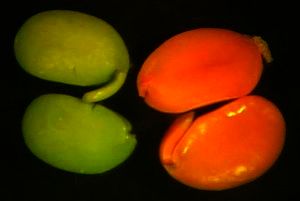Several animals depend on naturally occurring carotenoids in their diet. These carotenoids can be important to animal health, but also contribute to animal products that are visually appealing to consumers. When raised in captivity, animals do not have access to their normal dietary carotenoids; consequently, these same carotenoids must be supplied in their diets. Yet, dietary supplementation with carotenoids does not come cheap, and can account for 15-25% of total feed costs. The most cost-economical way to incorporate these natural carotenoids back into the animal diets would be by producing them in the soybean used as feed for them.


One such carotenoid is canthaxanthin, which plays an important role in obtaining proper egg yolk coloration, as can be observed in the photo at right. Without carotenoids, egg yolks are white. Without red carotenoids, yolks can be an unpleasant yellow color. Canthaxanthin is the pigment that gives flamingos their distinct coloration.
“The pink or red ketocarotenoids, canthaxanthin and astaxanthin, are used as feed additives in the poultry and aquaculture industries as a source of egg yolk and flesh pigmentation, as farmed animals do not have access to the carotenoid sources of their wild counterparts. Because soybean is already an important component in animal feed, production of these carotenoids in soybean could be a cost-effective means of delivery. In order to characterize the ability of soybean seed to produce carotenoids, soybean cv. Jack was transformed with the crtB gene from Pantoea ananatis, which codes for phytoene synthase, an enzyme which catalyzes the first committed step in the carotenoid pathway. The crtB gene was engineered
–Ketocarotenoid Production in Soybean Seeds through Metabolic Engineering
together in combinations with ketolase genes (crtW from Brevundimonas sp. strain SD212 and bkt1 from Haematococcus pluvialis) to produce ketocarotenoids; all genes were placed under the control of seed-specific promoters. HPLC results howed that canthaxanthin is present in the transgenic seeds at levels up to 52 μg/g dry weight. Transgenic seeds also ccumulated other compounds in the carotenoid pathway, such as astaxanthin, lutein, β-carotene, phytoene, α-carotene, lycopene, and β-cryptoxanthin, whereas lutein was the only one of these detected in non-transgenic seeds. The ccumulation of astaxanthin, which requires a βcarotene hydroxylase in addition to a β-carotene ketolase, in the transgenic seeds suggests that an endogenous soybean enzyme is able to work in combination with the ketolase transgene. Soybean seeds that accumulate ketocarotenoids could potentially be used in animal feed to reduce or eliminate the need for the costly addition of these compounds.”

Soybean seeds from events producing canthaxanthin.
The top row in each panel is of wild-type (WT) soybean cultivar Jack. The second row is of carotene-accumulating seeds resulting from transformation with crtB. The third row is of seeds containing canthaxanthin after transformation with pCEH1B+bkt (left panel) or pCEH1B+crtW (right panel). The cotyledons from one seed have been separated in each case.
